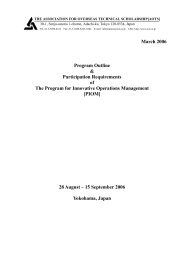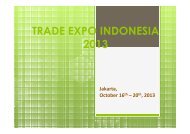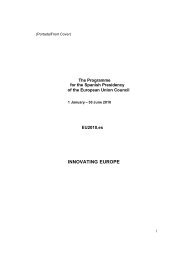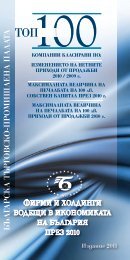Analysis of the Operation and Financial Condition of the Enterprise
Analysis of the Operation and Financial Condition of the Enterprise
Analysis of the Operation and Financial Condition of the Enterprise
Create successful ePaper yourself
Turn your PDF publications into a flip-book with our unique Google optimized e-Paper software.
<strong>Analysis</strong> <strong>of</strong> <strong>the</strong> <strong>Operation</strong> <strong>and</strong> <strong>Financial</strong> <strong>Condition</strong> <strong>of</strong> <strong>the</strong> <strong>Enterprise</strong>liquidity=(current) ratioCurrent liabilities(4.1.)Current liabilities are debts with <strong>the</strong> repayment term not exceeding one year. Currentliabilities are made up <strong>of</strong> such items <strong>of</strong> balance sheet liabilities like bank loans, bills <strong>of</strong>exchange payable, trade accounts payable, customers’ advances, taxation payable, salariespayable etc.Current or short-term assets are assets that are used, consumed or sold within asingle reporting period. These include cash assets, short-term financial investments,accounts receivable <strong>and</strong> stock <strong>of</strong> raw materials for production <strong>of</strong> goods.The absolute or overall liquidity ratio (current ratio) describes <strong>the</strong> capacity <strong>of</strong> anenterprise to repay its short-term debts. The higher this ratio is <strong>the</strong> higher <strong>the</strong> payingcapacity (solvency) <strong>of</strong> an enterprise estimated. Changes in this ratio must be looked at in adynamic perspective. In accordance with <strong>the</strong> generally accepted international st<strong>and</strong>ards it isbelieved that this ratio must be within <strong>the</strong> limits <strong>of</strong> 1 <strong>and</strong> 2 (sometimes 3). The lower limitis preset as 1, because <strong>the</strong> amount <strong>of</strong> current assets in any enterprise must be at least ashigh as to be able to meet its current liabilities, o<strong>the</strong>rwise <strong>the</strong> enterprise may facedifficulties in settlement <strong>of</strong> its short-term debts. The excess <strong>of</strong> current assets over currentdebts <strong>of</strong> above two or three times also is not desirable as this may be a pro<strong>of</strong> or anirrational capital structure – <strong>the</strong> enterprise has invested too much in <strong>the</strong> current asset itemsor has insufficiently used its short-term loans.The overall liquidity ratio (current ratio) can be raised in two ways: ei<strong>the</strong>r byincreasing <strong>the</strong> value <strong>of</strong> some current asset items or reducing <strong>the</strong> value <strong>of</strong> its short-termdebts.If stock <strong>and</strong> prepaid expenses are deducted from <strong>the</strong> current assets, it is possibleto calculate <strong>the</strong> quick ratio which is expressed by dividing <strong>the</strong> liquid assets by currentliabilities:Quick ratio=Current assets – (Stock + Prepaid expenses)Current liabilities(4.2)There can be o<strong>the</strong>r formulas found in <strong>the</strong> sources <strong>of</strong> reference according to which <strong>the</strong> quickratio is calculated, although <strong>the</strong> ma<strong>the</strong>matical outcome remains <strong>the</strong> same:Quick ratio =Cash + Short-term securities + accounts receivableCurrent liabilities(4.3.)This ratio shows <strong>the</strong> asset capital involved in <strong>the</strong> enterprise operations which isestimated as <strong>the</strong> difference between <strong>the</strong> amounts <strong>of</strong> current assets <strong>and</strong> current liabilities70



